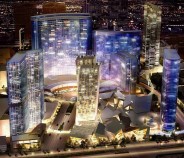Roxy Palace has slot tournaments 24 hours a day with guaranteed freerolls and free buy-ins. There's a huge variety of types of tourneys to enjoy. Sign up now, join the fun and win some cash!
Inspectors Note Unresolved Deficiencies at CityCenter Construction
Alan Maimon
Las Vegas Gaming Wire
LAS VEGAS, Nevada -- It is five months until the first tower is set to open at CityCenter, one of the largest private construction projects in U.S. history, but
MGM MIRAGE CityCenter general contractor Perini Building Co. has not yet resolved numerous construction deficiencies cited by inspectors.
Perini's slow approach to fixing the discrepancies makes it difficult to confirm that actual construction work matches building plans sanctioned by the county.
The Review-Journal has analyzed the discrepancies inspectors have reported to county building officials since construction began on the project in 2006.
Clark County and MGM Mirage, the project's owner, say every discrepancy will be eliminated before the buildings open for business; but some construction experts say late fixes may be costly, and impractical, to make.
MGM Mirage spokesman Alan Feldman downplayed the significance of the project's hundreds of unresolved discrepancies.
"By the time the buildings are open, there will be 100 percent resolution," Feldman said. "I haven't been involved in any project where something like this wasn't going on."
Lesley Pittman, spokeswoman for Perini Building Co., the general contractor for CityCenter, said the company's work at CityCenter was well within "established building and construction processes."
It is "factually untrue," she wrote, to suggest that Perini's work on CityCenter "has been done improperly or inconsistent with the County's existing legal and regulatory process."
Perini's compliance with existing processes isn't the issue. The question is whether it is wise to continue construction at breakneck speed, while construction discrepancies and work done with unapproved plans pile up.
Some CityCenter properties are scheduled to open later this year. The Vdara, a nongaming resort, has a planned Oct. 1 opening date. The 4,000-room Aria is scheduled to open Dec. 16.
OFFICIAL EXPRESSED CONCERN
Discrepancies, or noncompliance reports as they also are referred to by the county, document problems that third-party special inspectors find during construction, such as outdated plans, bad work or work that doesn't match the latest approved plan. If a problem persists or is deemed to be particularly serious, the county has the option of following up an inspector's report with a correction notice.
There is evidence some county personnel became concerned that up-to-date approved plans were often absent when special inspectors went to check steps of completed work at CityCenter.
On Feb. 9, a county inspector reacted by issuing a wide-reaching correction notice.
"Contractor working without Clark County approved plans," Kurt Stone wrote in the notice, which referenced all building permits at the site.
The choice to let workers build as project designers revise the original plans -- with supporting papers and county approvals sometimes still missing months or years later -- can impact CityCenter's final construction price tag, and even the safety of future employees and guests, experts say.
But county spokesman Dan Kulin said the county doesn't study discrepancy logs for any given job site to pinpoint trends during construction. The logs do come into play as a job nears completion.
"Everything needs to be resolved before we issue a certificate of occupancy," Kulin emphasized.
Without the certificate, no building can open for business.
HARMON TOWER IS NOT ALONE
The beleaguered Harmon Hotel leads the pack in percentage of discrepancies -- 69 percent -- that remained unfixed at CityCenter as of Feb. 13, the newspaper's analysis shows.
The Harmon's height has been almost halved from the original design, after serious construction errors were found in 15 of about 20 completed floors. Negative publicity streamed from the discovery last summer.
In January, project owners MGM Mirage and Dubai World announced the deletion of Harmon's 200 condo units, portraying the decision to downsize as economically motivated in the present recession.
Project owners had decided it was cheaper to reduce the building's final height, and do less costly fixes, than to fully correct errors in the 15 floors. The errors had compromised the ability of a full-sized Harmon to withstand sideways forces including wind or earthquake.
CityCenter's other towers also have hundreds of unresolved discrepancies, county logs show. In contrast to the Harmon's 69 percent unresolved rate, other structures varied in their rates from 40 percent at the low-rise "west podium" to 22 percent at the Vdara.
Whether rates of unresolved discrepancies this high are the norm at Las Vegas high-rise construction projects is difficult to measure, because the county doesn't keep records on this subject. Kulin said it would be difficult for the county to produce comparable records for already completed projects, showing the status of discrepancies during construction.
'SHEER MAGNITUDE' QUESTIONED
Felix Martin, a forensic structural engineer based in Southern California, makes his living analyzing data for and testifying in construction defect lawsuits. Based on his experience, he believes CityCenter's unresolved rate should be no higher than about 10 percent.
"I'm concerned about the sheer magnitude" of unresolved discrepancies and missing approvals at the CityCenter project, Martin said after he reviewed the spreadsheets in which the Review-Journal dissected the CityCenter logs.
There is no industry standard for acceptable rates of unresolved discrepancies at a large, complex project such as CityCenter, or for how frequently special inspectors usually cite unapproved documents when they examine a piece of completed work.
Generally, construction professionals consider logged items as unimportant "fleas on a camel's back," said Martin, the owner of Marcon Forensics.
But, referring to the Harmon problems -- in which substantial errors persisted as the building rose 15 floors -- Martin said, "If you're building the obvious incorrectly, how can you guarantee the less obvious has been done correctly?"
MGM Mirage officials contend the unresolved discrepancy rates at CityCenter aren't unusually high.
"Many of these things are very minor," MGM Mirage spokesman Gordon Absher said in February. "And some are as simple as the engineering review process catching up with what's happening at the site."
He was talking about the volume of discrepancies then being logged by inspectors.
Kulin said the county's system for tracking construction discrepancies speaks for itself.
"It shows that we're keeping track of NCR's (noncompliance reports) that are out there. ... It's up to you as to what you find interesting."
County officials Phil Rosenquist, Ron Lynn and Greg Franklin were not available to talk during the 10 days in April that the newspaper made repeated requests to interview one of the three. Rosenquist is the assistant county manager over county development services, which Lynn heads. Lynn supervises Franklin, who heads the building division.
WHAT THE NUMBERS SHOW
The Review-Journal analysis of CityCenter found two trends:
• When Perini requested a special inspection, third-party inspectors frequently reported they had to work with either an old plan, an unapproved revision or no plan at all. Inspectors need the latest approved revision when they examine work.
• After third-party inspectors logged discrepancies, Perini has let a high proportion of them dangle unresolved for long spans of time.
The Review-Journal undertook its analysis as a way to evaluate numerous complaints it has received from CityCenter workers -- past and present -- who are engineers, inspectors and tradesmen.
The newspaper tabulated and sorted the discrepancies in the county logs, which consist of report summaries from third-party special inspectors at the project. Inspectors repeatedly cited the lack of approved documents -- drawings, details or plans -- in their daily reports.
"They're putting this up like you'd put up a (home) garage," is how one angry former field engineer described the lack of official paperwork.
Laid off from Perini several months ago, the engineer -- like other workers who contacted the newspaper -- declined to be identified in print. Some said they had expressed their concerns to supervisors, but were ignored. All feared they would either lose their jobs, or be blacklisted from future jobs.
Third-party special inspectors examine only aspects of construction -- involving concrete, masonry or steel -- that either are highly technical or require intensive monitoring. County inspectors handle less technical work, such as electrical, plumbing or heating-cooling installation.
Examples of inadequate work that third-party inspectors have logged include concrete batches or column splices that didn't test as strong as approved documents call for.
Most, but not all, of what appear to be serious discrepancies are marked as resolved in logs.
The newspaper looked at CityCenter logs for the Harmon and Aria hotel towers; the Mandarin and Vdara towers, which have both hotel rooms and residences; and at Veer Towers, which is strictly residential. It also looked at the county's discrepancy logs for the two low-rise portions of CityCenter that will house the casino and employee areas.
The newspaper scrutinized site activity from 2006 through Feb. 13, which was the day it received its log copies.
SLOW FIXES DON'T FAZE COUNTY
County officials don't appear concerned, either, with the slow pace for resolving discrepancies at CityCenter, some of which date back to 2007 and are still open.
"It's whether it's resolved, not how long" it took to resolve, Kulin said. "It's up to the owner or contractor to determine when and how they will address" discrepancies.
That contrasts with the experience of forensic engineer Martin, who said most discrepancies at most projects can be closed in two weeks.
A more complex discrepancy might take several months, according to both Martin and Charles Moore, who is with a financial restructuring firm near Detroit and is familiar with construction management at large job sites.
Kami Farahmandpour, founder of Building Technology Consultants in Arlington Heights, Ill., said resolution of the discrepancies is a serious matter.
"One can deduce that some of the discrepancies indicated in the spreadsheet (if left unresolved) may ultimately cause life safety concerns and code violation," he said after reviewing the newspaper's analysis of county data.
Unresolved discrepancies in the spreadsheet viewed by Farahmandpour include an issue with masonry reinforcement and four instances of unapproved work.
Some county documents pertaining to CityCenter contradict Kulin's contention that a contractor can choose how long to let discrepancies stay open.
On July 9, 2008, county inspector Mike Kemper issued two correction notices for discrepancies that were "not being cleared in a timely manner" at the west low-rise building.
"NCR's need to be addressed within 10 working days to prevent further action," Kemper wrote in both notices, which pertain to different areas at CityCenter.
The 10-day deadline is not county policy, but came at the inspector's discretion, according to Kulin.
As of mid-February, the Review-Journal's database showed that 75 percent of unresolved discrepancies at CityCenter's west low-rise building were at least five months old; 74 percent were that old at Vdara; 64 percent at Veer Towers; 59 percent at the project's east low-rise building.
The Harmon had the lowest rate, 10 percent, for unresolved discrepancies five months or older, perhaps because of recent intensive scrutiny because of the well-publicized construction errors.
At the project's west low-rise building, 52 instances of column splices with "less than 75 percent bearing" were still open in mid-February. All the discrepancies date back to either May 8 or June 21 of 2007. The phrase refers to a column not measuring up to prescribed strength.
A sample of other long-standing discrepancies still open on Feb. 13 include: piping in a basement level doesn't match plan (noted at Veer Towers on April 27, 2007); no approved document on file to justify a particular use of epoxy in the foundation (at east low-rise on May 9, 2007); no permit for cabana work (at Harmon on July 16, 2007).
Nor do the CityCenter logs list any resolution dates for discrepancies that have been closed.
Omitting closure dates from discrepancy logs is not common practice, said both Martin and Fred Deis, an official with the Portland, Ore., building department.
RISK OF LAWSUITS
Discrepancies that go unresolved for long spans of time carry a risk, several interviewed parties said.
They disagree that all discrepancies can simply be cleared up at the tail end of a project. Older work tagged with an open discrepancy may have been concealed by subsequent layers of work.
Even the county admits that one risk of that is greater expense to the builder or owner.
"It could lead to them having to ... rip out and redo the work," Kulin said. "Or they may have to submit revised plans, which certainly carry some sort of cost, additional engineering and that sort of thing."
There also is a safety risk, should work that was built without approved plans contain an error.
The harshest example of that in hotel history is the 1981 collapse of suspended walkways in a crowd-filled atrium at the Kansas City Hyatt Regency. The failure, which killed 114 people, was later linked partially to a poorly vetted revision of the plan that was originally approved for the walkways.
"The bottom line is, speed will kill, whether it's driving or construction," Deis said. "There's a reason ... that inspectors have record sets that are stamped properly," to show which approvals the plans have received.
Martin's bottom line is that projects with high unresolved rates for logged discrepancies tend to be the sort that end in construction litigation.
That prospect is sure to sour the stomachs of the principal players at CityCenter. MGM Mirage and Dubai World already are wrestling over terms of their CityCenter partnership.
Meanwhile Perini Building Co. is embroiled in a federal lawsuit in which investors contend the company misled them on the status of its Las Vegas projects, including CityCenter.
Las Vegas, NV 89109
Fax: (702) 693-8626
Website: www.mgm-mirage.com
| MGM MIRAGE is one of the world's leading gaming companies. It owns and operates 24 properties located in Nevada, Mississippi and Michigan, and has investments in four other properties in Nevada, New Jersey, Illinois and the United Kingdom. MGM MIRAGE has also announced plans to develop Project CityCenter, a multi-billion dollar mixed-use urban development project in the heart of Las Vegas, and has a 50 percent interest in MGM Grand Macau. |

